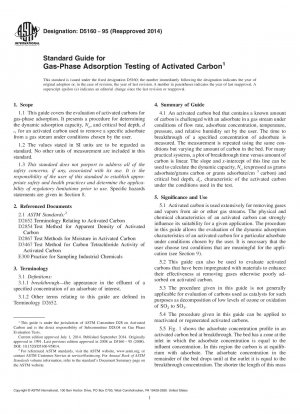ASTM D5160-95(2014)
Standard Guide for Gas-Phase Adsorption Testing of Activated Carbon
- Standard No.
- ASTM D5160-95(2014)
- Release Date
- 1995
- Published By
- American Society for Testing and Materials (ASTM)
- Status
- Replace By
- ASTM D5160-95(2019)
- Latest
- ASTM D5160-95(2019)
- Scope
5.1 Activated carbon is used extensively for removing gases and vapors from air or other gas streams. The physical and chemical characteristics of an activated carbon can strongly influence its suitability for a given application. The procedure in this guide allows the evaluation of the dynamic adsorption characteristics of an activated carbon for a particular adsorbate under conditions chosen by the user. It is necessary that the user choose test conditions that are meaningful for the application (see Section 9).
5.2 This guide can also be used to evaluate activated carbons that have been impregnated with materials to enhance their effectiveness at removing gases otherwise poorly adsorbed on activated carbon.
5.3 The procedure given in this guide is not generally applicable for evaluation of carbons used as catalysts for such purposes as decomposition of low levels of ozone or oxidation of SO2 to SO3.
5.4 The procedure given in this guide can be applied to reactivated or regenerated activated carbons.
5.5 Fig. 1 shows the adsorbate concentration profile in an activated carbon bed at breakthrough. The bed has a zone at the inlet in which the adsorbate concentration is equal to the influent concentration. In this region the carbon is at equilibrium with adsorbate. The adsorbate concentration in the remainder of the bed drops until at the outlet it is equal to the breakthrough concentration. The shorter the length of this mass transfer zone (adsorption zone), the more effectively the carbon in the bed is utilized. A bed whose depth is less than the length of this zone will show immediate appearance of adsorbate in the effluent (breakpoint).
FIG. 1 Concentration Profile of an Activated Carbon Bed at Breakthrough

5.6 From the standpoint of best carbon utilization it is desirable to choose a carbon which will give as short a mass transfer zone as possible under use conditions. However, in many applications, high adsorptive capacity is more important than a short mass transfer zone. In almost every application, bed pressure drop is also a primary consideration.
5.7 In a few situations such as respiratory protection against low levels of extremely toxic gases such as radioactive methyl iodide, a short mass transfer zone (that is, high adsorption rate coefficient) is more important than ultimate capacity. In other cases such as solvent recovery, a high dynamic capacity is more important.
5.8 Although the design of adsorber beds is beyond the scope of this guide, the following points should be considered. The bed diameter s......
ASTM D5160-95(2014) Referenced Document
- ASTM D2652 Standard Terminology Relating to Activated Carbon
- ASTM D2854 Standard Test Method for Apparent Density of Activated Carbon*, 1996-04-20 Update
- ASTM D2867 Standard Test Methods for Moisture in Activated Carbon*, 1999-04-20 Update
- ASTM D3467 Standard Test Method for Carbon Tetrachloride Activity of Activated Carbon*, 2003-10-01 Update
- ASTM E300 Standard Practice for Sampling Industrial Chemicals
ASTM D5160-95(2014) history
- 2019 ASTM D5160-95(2019) Standard Guide for Gas-Phase Adsorption Testing of Activated Carbon
- 1995 ASTM D5160-95(2014) Standard Guide for Gas-Phase Adsorption Testing of Activated Carbon
- 1995 ASTM D5160-95(2008) Standard Guide for Gas-Phase Adsorption Testing of Activated Carbon
- 1995 ASTM D5160-95(2003) Standard Guide for Gas-Phase Adsorption Testing of Activated Carbon
- 1998 ASTM D5160-95(1998) Standard Guide for Gas-Phase Adsorption Testing of Activated Carbon

Copyright ©2024 All Rights Reserved
